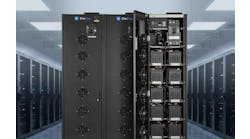Five Compelling Reasons to Consider Natural Gas for Data Center Projects
Companies developing data centers are in a new era in which the scope of project planning must expand far beyond the data center itself and into the supporting physical infrastructure – power generation, water delivery and water treatment. Delays in this physical infrastructure have led to new ideas that open the window for options that previously had not been on the table.
One option now being explored by developers of new-build data centers is the use of natural gas for power generation – either for self-generation of the entire complex or for backup only. Owners are learning there are some compelling reasons to give natural gas serious consideration.
Let’s look at five important rationales:
- Significant cost savings for natural gas. Data center operators can save 38 to 45 percent of the cost to generate the same amount of electricity when considering the fuel source of natural gas versus diesel fuel. Although natural gas has a higher burn rate than diesel, the cost of natural gas is much lower, allowing for the substantial savings. Such cost efficiencies would be especially beneficial to hyperscale facilities requiring many large generators. The expectation of continued low pricing for natural gas is a major advantage going forward.
- Multiple utilization and monetization options with natural gas. Diesel generators typically are used to provide backup power to data centers and only deployed in a power emergency or outage. Natural gas-powered generators can be used in a variety of ways beyond just as backup power. Depending on market location and utility regulations, owners could sell excess power back to the utility or to the spinning reserve wholesale power market. They’d also have the option to use natural gas to peak shave, thereby reducing demand charges. Natural gas also could be used to provide grid emergency response services. These monetization options are available whether the natural gas generation is for supporting regular operations or for backup.
- Substantially cleaner fuel emissions and more versatility. Natural gas burns cleaner with lower emissions of carbon dioxide and nitrous oxide. Conversely, diesel emits more sulphur, nitrogen oxide and carbon dioxide. Natural gas also offers a higher potential for successful air permit approvals, and it provides for less noise pollution than diesel generators. It is stored in pipelines and is readily available on demand. Generally speaking, diesel fuel is only usable in storage for up to 24 months, meaning an operational maintenance plan is required to optimize performance.
- Rapid progress in natural gas efficiency. There’s little doubt natural gas will become an even cleaner and more efficient resource in the future. Today, combined-cycle natural gas plants can achieve efficiency rates of 50 to 60 percent – and expected to exceed 65 percent within a few years. Advanced turbines operate with 30 to 50 percent hydrogen fuel content, and conversion to more efficient models is expected to advance, making them more cost-efficient. Operating with a higher hydrogen content will achieve cleaner operations. Eventually, that hydrogen content could reach 100 percent, with the ultimate goal of emitting nothing but water in order to comply with 2050 net-zero goals.
- New focus on futureproofing. The idea of futureproofing is anticipating ways to keep assets useful, relevant and adaptive for productive use far into the future, helping ensure that today’s investments don’t become tomorrow’s stranded assets. One technology that could help safeguard natural gas relevancy decades from now is carbon capture, utilization and sequestration (CCUS). CCUS is projected to have the ability to capture and harness 90 percent of carbon dioxide emissions and produce carbon-based products of value. Certain industries are showing significant interest in this development today, and they are anticipated to embrace and put the technologies to work by 2030. This will signal a new direction for utility companies. Economy of scales could be achieved by 2040 that will allow for large-scale CCUS retrofits at natural gas plants. This exciting technology is actively in the experimental or pilot stages, and its development and progress will only advance.
An Efficient Fuel
Compared to other fossil fuels, natural gas offers superior efficiency rates, lower emissions and an abundant, reliable supply. Its lower carbon dioxide per unit of electricity is a huge plus for reaching green, sustainable goals.
As data center managers grapple with utilities being challenged to meet their power needs for new projects, they are having to think outside the box and look at self-generation of power or constructing their own substations. Whether used for power generation or backup, natural gas can be the perfect technology to ensure grid reliability.
For decades, Black & Veatch has designed and constructed natural gas power plants around the globe. We’ve also completed the design of a natural gas backup power installation at a new-build data center. Data center owners increasingly are exploring the benefits of using natural gas, and it is a trend that will only continue to grow.

Phil Fischer
Phil Fischer is a client executive for the data center and mission critical segment at Black & Veatch. He has more than 25 years of experience in the distributed generation and data center industry while working at Black & Veatch and other leading providers including NEC Energy Solutions, American Power Conversion, Schneider Electric, Eaton, and Nidec Industrial Solutions. Phil brings a thorough and holistic understanding of development, design, construction, and operation of data center and mission critical facilities, including site due diligence and selection, master planning, data center design, power generation (thermal, renewables, and nuclear), power transmission and distribution, water and cooling, and fiber planning.
Black & Veatch is a 100-percent employee-owned global engineering, procurement, consulting and construction company with a more than 100-year track record of innovation in sustainable infrastructure. Since 1915, we have helped our clients improve the lives of people around the world by addressing the resilience and reliability of our most important infrastructure assets. Follow Black & Veatch on LinkedIn, Facebook, X (Twitter) and Instagram.






